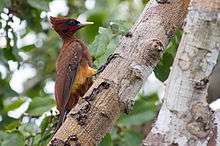Chestnut woodpecker
The chestnut woodpecker (Celeus elegans) is a resident breeding bird in South America from Colombia, Venezuela and the Guianas south to Ecuador, Bolivia and northern and western Brazil, and on Trinidad. It is found in a range of habitat types including rainforest, gallery forest, seasonally flooded forest, mangrove woodland, swamps, plantations and wooded savannah.[3] It is a generally uncommon bird, and threatened by habitat loss, but it has a very wide range, and the International Union for Conservation of Nature has assessed its conservation status as being of least concern.[1]
| Chestnut woodpecker | |
|---|---|
 | |
| Scientific classification | |
| Kingdom: | Animalia |
| Phylum: | Chordata |
| Class: | Aves |
| Order: | Piciformes |
| Family: | Picidae |
| Genus: | Celeus |
| Species: | C. elegans |
| Binomial name | |
| Celeus elegans Muller, 1776 | |
| Subspecies | |
| |
The chestnut woodpecker is about 28 cm (11 in) long and weighs about 127 g (4 oz). The upper parts, wings and breast are a rich unbarred chestnut brown, while the rump, belly, flanks and crest are yellow or cinnamon, depending on race. The tail is blackish, the legs are grey and the bill yellow-white. The male has a red malar stripe, but otherwise the sexes are similar. C. e. leotaudi of Trinidad is smaller, paler, and much brighter than the mainland forms. Other subspecies have differing crest colours.[3]
The habitat of this large woodpecker is forest and other closed woodland. The nest hole is in a dead tree, with the chamber floor up to 30 cm below the entrance. Three white eggs are laid. The chestnut woodpecker mainly feeds in trees and bushes on insects, including ants and termites, and some fruit. It sometimes breaks into termite mounds and follows swarms of insects; it forages in the middle and lower stories of the forest, sometimes in the company of other smaller birds. It is a noisy species with a harsh parrot-like squawk whEEjer. Both sexes drum.[3]
References
- BirdLife International (2012). "Celeus elegans". IUCN Red List of Threatened Species. 2012. Retrieved 26 November 2013.CS1 maint: ref=harv (link)
- http://www.hbw.com/species/chestnut-woodpecker-celeus-elegans
- Gorman, Gerard (2014). Woodpeckers of the World: A Photographic Guide. Firefly Books. p. 371–372. ISBN 177085309X.
- ffrench, Richard (1991). A Guide to the Birds of Trinidad and Tobago (2nd ed.). Comstock Publishing. ISBN 0-8014-9792-2.
- Hilty, Steven L (2003). Birds of Venezuela. London: Christopher Helm. ISBN 0-7136-6418-5.
External links
| Wikimedia Commons has media related to Celeus elegans. |
- Chestnut woodpecker videos on the Internet Bird Collection
- Chestnut woodpecker photo gallery VIREO Photo-High Res
- Photo-High Res; Article geometer.org–(Trinidad and Tobago)
